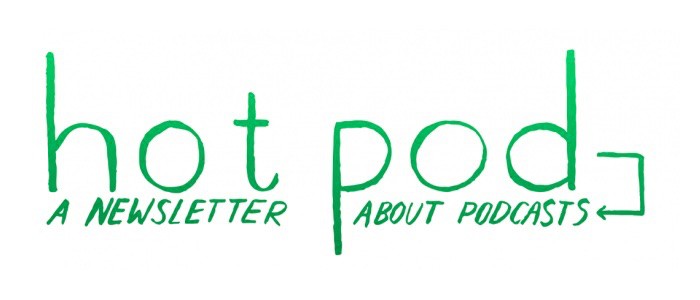
Welcome to Hot Pod, a newsletter about podcasts. This is Issue Fifty-Four, published January 5, 2016.
Mailchimp tries product placement, but behind a wall. A recent Forbes piece, published shortly before Christmas, mentioned that an upcoming audio drama within Midroll’s premium content subscription service, Howl, will feature integrated product placement by Mailchimp, that reliable war horse of podcast advertising money. According to the article, the email newsletter service (which powers Hot Pod’s email delivery, by the way, and Nieman Lab’s) will apparently “contribute native content that exists inside of the storyline.”
The podcast itself sounds fascinating: Entitled Fruit, the drama is set to be a scripted first-person narrative drama about X, an African-American professional football player who is gay. The project is created by Issa Rae, of The Misadventures of Awkward Black Girl YouTube series fame. Rae is also developing a new show for HBO, Insecure, which the network has picked up for a series order, according to Deadline.
Anyway, here’s what I find super interesting about the whole product placement aspect, particularly from Mailchimp’s end:
Fruit is scheduled to premiere in the Howl Premium subscription service next month.

Dynamic ad insertion: A new norm, as-yet-unknown consequences. Continuing its formidable coverage of the podcast space, the Financial Times published a piece before the new year that put a spotlight on dynamic ad insertion technology, which is expected to mature within the medium this year. The piece called dynamic ad insertion “the new normal.”
In case you’re unfamiliar, here’s what you need to know: Dynamic insertion allows audio producers to easily swap out ad spots within a given podcast episode. Previously, if a producer wanted to resell ads on older episodes — evergreen listenership is a real boon in podcasting — she had to manually edit the audio file and reupload it into the CMS. This is, of course, a major structural limitation. Aside from possible analytics-related complications, there’s also a problem of scale: The time taken for the producer to switch out ads in multiple old episodes may be too much to warrant the paperwork.
Right now, there are only a few major audio/radio/podcasting players who boast dynamic ad insertion technology, and the Financial Times piece singles out two of the more interesting companies whose business models are conceivably predicated on the success of these platforms: Panoply (repeated disclaimer: my employer) and Acast. But this technology is also in use at a few public radio stations and related institutions: WNYC, NPR, and Serial (as covered in a previous Hot Pod), among others.
One might surmise that this technology is a crucial step towards the “modernization” of podcasts — technological intervention to break down and control the distributional unit of content. But like all modernizing pieces of technology (fire, combustion engines, Facebook, etc.), it’s a Pandora’s Box. One that, well, looks pretty familiar.
With dynamic ad insertion technology, advertising real estate in an audio file is no longer finite. And while that doesn’t necessarily lead to a situation where podcast advertising real estate is infinite, it does lead to an increase in ad inventory supply for podcast creators per episode and a relative decrease in potential competition among advertisers for slots in a given podcast episode.
It’s possible that the combination of these two things — increased supply, diffused demand — at scale would end up constituting a force that ultimately drives down podcasting’s high CPMs (cost per thousand listeners), which currently ranges between $15-$30 per the aforementioned Financial Times piece. But while I’m prone to doomsday scenarios, I’m also hopeful that this potential effect could be counterbalanced by:
Speaking of which: Where did podcasting’s high CPMs come from, anyway? That’s an investigation for another, future Hot Pod. Stay tuned.

Slow food, but for investigative reporting. It’s a big start to 2016 for the Center for Investigative Reporting’s Reveal podcast, which is both shifting from biweekly to weekly and scaling up its team. (By the way, if you’re looking for a job in the Bay Area and are cool with sunshine, drought, and hordes of hoodied dudes, hit it up.)
Launched last January in partnership with PRX, which serves as a coproducer and broadcast distributor, the show served audiences hard-hitting and narratively compelling pieces of investigative journalism from all over. “We view the podcast as a platform,” said Joaquin Alvarado, CIR’s CEO. “We didn’t just populate Reveal with just CIR reporting. The opportunity, for us, is to highlight from all of the great investigative reporting out there.”
According to Alvarado, that initiative involved working with journalists from a ton of different newsrooms — many of whom primarily came from print or video documentary with little radio experience under their belt. Part of the process involved the Reveal team partnering with these journalists to adapt their work to audio. “We try to cross-train as much as possible.”
Alvarado’s description reminded me a lot of an anecdote told by California Sunday Magazine’s Doug McGray in his recent interview on the Longform podcast (14:00, for reference), which depicted the manner in which This American Life producers collaborated with McGray, who previously held no radio experience, on a broadcast piece. I’m sure this is a standard method of practice for a bunch of other podcasts and radio shows, but I just wanted an excuse to highlight this McGray interview in particular, which is fantastic.
Anyway, Reveal’s expansion comes at a time when investigative journalism continues to battle with declining resources. Interestingly, though, it has found itself with some renewed attention over the past few months due to the movie Spotlight, about The Boston Globe’s reporting in the early 2000s on the child sex abuse scandal in the Catholic Church. (It’s really great and you should totally see it and man, Michael Keaton, the original cinematic Batman.)
I asked Alvarado what he thinks is up with American investigative journalism. “It’s like the slow food movement. For many generations, American food was shit,” Alvarado said. Over time, he argued, this scenario led to an environment where quality really stood out, and soon companies began organizing around quality. “Think about how Whole Foods has rebranded good food sourcing,” he said. It’s an optimistic view, but I’m hopeful that investigative journalism will come out a lot cheaper than Whole Foods.
Another public to private. Steve Henn, formerly a Bay Area tech correspondent for NPR and Planet Money, published a post on Medium (where else?) yesterday announcing his departure from public radio. The post briefly outlined his reasoning, which is principally oriented around a dissatisfaction with the public radio system’s navigation of the digital space. Henn also cited his ambitions to build “a new kind of radio” — a venture that’s associated with this website.
Henn is the latest in a laundry list of public radio folks jumping into the private space, which includes: Audible’s Eric Nuzum, Midroll’s Chris Bannon, Australian Broadcasting Corporation’s Julie Shapiro (she counts, dammit!), FiveThirtyEight’s Jody Avirgan, BuzzFeed’s Jenna Weiss-Berman, along with Acast’s Caitlin Thompson and Sarah Van Mosel. And then, of course, there’s Gimlet Media’s Alex Blumberg along with a significant chunk of his staff (including Lisa Chow, PJ & Alex, Caitlin Kenney, Peter Clowney, oh man I’m not going to continue down this list). Oh, and let’s not forget O.G. departee Andy Bowers, my day job boss at Panoply, along with a significant chunk of staff (Laura Mayer, AC Valdez, Sam Dingman, Henry M — oh boy).
Seriously, I should just make a damn public spreadsheet already. Geez.
Phew! Okay, a short Hot Pod this week to kick off the new year. I’m a little rusty — gotta get back on the saddle. See you next week, folks!
Is this your first time reading Hot Pod? You can subscribe to the newsletter here, which mostly features irrelevant exclusive content (mostly different GIFs and stuff about what I had for lunch but whatever that’s the newsletter strategy I’m rolling with).
Nicholas Quah heads audience development at Panoply. Hot Pod is his weekly newsletter on the state of the podcast world; it appears on Nieman Lab on Tuesdays.